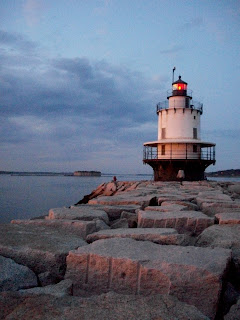
I remember the first time Lisa and I walked down a path in Cape Elizabeth. The trail took us through a mix of forest and meadow, crossing streams that flow with the deep obscuring reds of tannins released by trees into the water. We could feel the mystery that comes with arriving to the edge of the coastline - catching small currents of salt in the air when no water is in sight. The meadow abruptly stopped at a crest of grasses and the sprawling sea suddenly appeared to lay out before us. This is how we were introduced to Crescent Beach State Park in Maine. It has become a frequent stop for me to paint at, think at, nap at, play at, and get my feet soaked in it. The park has become a special and close getaway for Lisa and I to walk for an hour or two. Lying only six miles from our apartment in Portland, it's surprising how often we have the area to ourselves.
Crescent Beach State Park is a pretty literal name for the area, being a Crescent [shaped] [rocky] Beach [owned by the] State Park [system] and all. The geology of Crescent Beach State Park begins approximately 500 million years ago at the end of the Cambrian Period. An ocean covered all of Maine at that time, and the shoreline of the North American continent was located almost 300 miles to the northwest. In what is now the Portland area a great thickness of mud, sand, and limy mud accumulated on the ocean floor to form the area we now frequently take walks at. The rocks are also quite weathered looking, resembling petrified wood in their appearance.

Is this Lisa laughing in the face of death? Quite possible. Or are we simply beach nerds?

Low tide.
Just up the road toward Portland lies a area of jagged rocks and cliffs called Two Lights State Park. (All of you loyal readers out there,meaning our families, see an image from Two Lights at the header of the page every time you access this blog.) It is here that Lisa found a nesting spot in Maine - the perfected idea of a flat, hidden bed of rock that sits above the ocean but remains out of view from visitors. On sunny days when the rocks trap heat you can't even budge Lisa from this nook. It is also here, at Two Lights, where we have seen the largest waves of our lives! Sixteen foot high waves smashing into the rocks, sending spray to the level of most houses! Amidst both the turbulence and the calmer days we can always spot common eiders surfing the waves, diving for food. When the larger waves approach, some of these members of Anatidae will simply float over the crests while others dive beneath the surface, remaining visible through the pipelines.




There's that nook I spoke of.















































